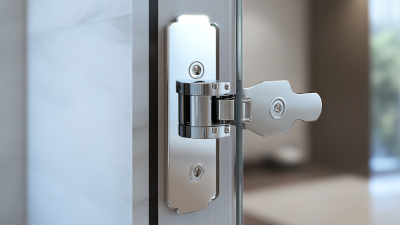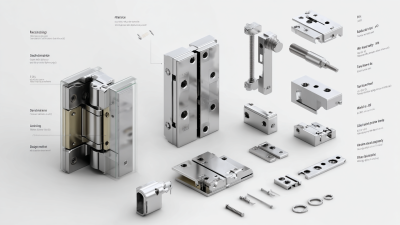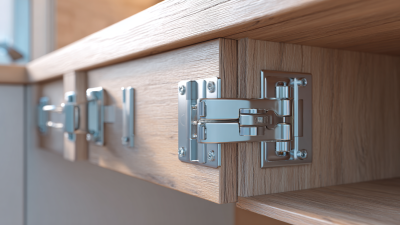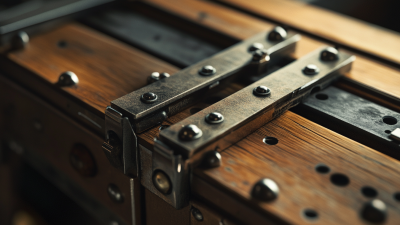Leave Your Message
In modern architecture, the role of hardware components, particularly Aluminum Glass Door Hinges, has become increasingly crucial, not just for functionality but also for enhancing aesthetic appeal. According to a recent report by the International Association of Architectural Hardware, the demand for durable and visually appealing hinges is projected to grow by 7% annually through 2025, driven by a trend toward open, glass-fronted buildings that emphasize natural light and connectivity with the outdoors. Aluminum Glass Door Hinges are specifically designed to withstand the rigors of frequent use while maintaining a sleek, minimalist look that complements modern designs. These hinges are engineered to support the weight of large glass panels without compromising safety, making them a preferred choice among architects and builders committed to quality and innovation. Understanding the intricacies of these hinges is essential for anyone involved in contemporary architectural projects, ensuring durability and aesthetic harmony in their designs.

When it comes to modern architecture, the strength properties of aluminum are becoming increasingly significant, particularly in the realm of door hinges. Aluminum offers an excellent combination of lightweight nature and robust durability, making it an ideal choice for sophisticated designs that require reliable functionality. While the material is celebrated for its resistance to rust and corrosion, it is essential to consider that not all aluminum components are created equal. Recent reports highlight issues with corrosion in not only vehicles but also products featuring aluminum, such as door hinges. This reinforces the necessity of making informed decisions regarding the quality of aluminum used in architectural fixtures.
**Tips:** When choosing aluminum glass door hinges, always opt for high-grade aluminum to ensure longevity and resistance to environmental factors. Regular maintenance and inspections can help identify any signs of wear or corrosion early on. Additionally, consider finishes that enhance corrosion resistance, ensuring the aesthetic appeal and functionality of your fixtures are maintained over time. Selecting the right hardware can make a significant difference in the overall performance and durability of your modern architectural elements.
When selecting aluminum glass door hinges for modern architecture, understanding load capacity standards is crucial. These hinges must support not only the weight of the door but also withstand the stresses from frequent use and environmental factors. The load capacity is typically determined by the materials used, the design of the hinge, and the specific architectural requirements. Architects and builders need to assess the weight of the glass doors and the expected frequency of use to choose the appropriate hinges that meet or exceed regulatory standards.
Moreover, modern architecture often incorporates large glass panels, which can significantly increase the gravitational forces acting on the hinges. For this reason, it is essential to consult the manufacturer's specifications and choose hinges that comply with industry standards like those set by the American National Standards Institute (ANSI) or the International Organization for Standardization (ISO). This ensures that the hinges will provide long-lasting performance and safety, contributing to the overall durability of the architectural design. By prioritizing load capacity in hinge selection, architects can enhance the functionality and aesthetics of their glass door installations.

When it comes to selecting the right hinges for aluminum glass doors in modern architecture, understanding the nuances of corrosion resistance is paramount. Aluminum hinges inherently offer remarkable resistance to rust and corrosion compared to traditional steel hinges. This is largely due to aluminum's ability to form a protective oxide layer when exposed to the elements, which acts as a barrier preventing moisture and harmful substances from compromising the material. Thus, in environments prone to humidity or coastal exposure, aluminum hinges ensure long-lasting durability and functionality.
On the other hand, traditional door hinges, often made from steel, are more susceptible to rust without proper protective coatings. Even with galvanized or powder-coated finishes, these hinges may degrade over time, especially if the coating gets scratched or chipped. Such vulnerabilities can lead to increased maintenance needs and premature hinge replacement, making aluminum hinges a more cost-effective solution in the long run. Consequently, architects and builders increasingly favor aluminum over traditional materials, highlighting its superior performance and showcasing its relevance in contemporary design.
When installing aluminum glass door hinges, attention to detail is crucial to ensure maximum durability and functionality. One of the key techniques involves
properly aligning the hinges to distribute weight evenly. This not only prevents wear on the hinges but also enhances the door's overall performance.
Additionally, using high-quality screws that are resistant to rust and corrosion will keep the hinges securely in place, even when faced with fluctuating temperatures and humidity levels.
Another essential aspect of installation is sealing the edges where the hinges meet the door and the frame. Proper sealing will help to prevent moisture ingress, which can lead to deterioration over time. Incorporating adjustable hinges can also prove beneficial, as they allow for future alignments without the need for complete disassembly. As minimalist designs gain traction in modern architecture, ensuring that the hardware complements the overall aesthetic while maintaining structural integrity can enhance both the style and longevity of the installation.
When it comes to maintaining aluminum glass door hinges, understanding the best practices is crucial for ensuring their longevity and optimal performance. Regular cleaning is essential; dirt and debris can cause wear and tear on hinges over time. A study highlights that neglecting to clean door hardware can lead to a decrease in operational efficiency by nearly 25%. Implementing a routine maintenance schedule, which includes lubrication using silicone-based sprays, can significantly extend the lifespan of these hinges.

Moreover, monitoring the alignment of the doors is vital. Misalignment can place undue stress on the hinges, potentially leading to premature failure. Research indicates that approximately 30% of door-related issues stem from improper installation and alignment. Homeowners and building managers should regularly check for signs of wear and adjust as necessary to maintain smooth functionality. These simple practices can prevent the high costs associated with premature replacements and ensure that door systems remain durable and reliable in modern architecture.






